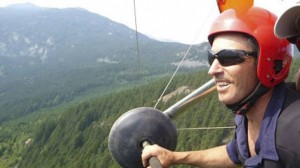 VANCOUVER – A hang-gliding pilot whose tandem passenger plunged to her death Saturday will remain in custody with the hope that he can produce evidence related to the fatal flight.
VANCOUVER – A hang-gliding pilot whose tandem passenger plunged to her death Saturday will remain in custody with the hope that he can produce evidence related to the fatal flight.
William Johnathan Orders, 50, is charged with obstruction of justice. He appeared briefly in B.C. Provincial Court in Chilliwack Wednesday afternoon and consented to remain in custody and his bail hearing was put over to Friday.
According to court documents, Orders allegedly swallowed a memory card attached to a wing-mounted camera after Lenami Godinez-Avila, 27, fell 300 metres to her death following takeoff from Mt. Woodside, near Agassiz, B.C., Saturday. Orders has been held by Upper Fraser Valley RCMP since that day.
“We have confirmed that the memory card is still inside,” RCMP spokeswoman Cpl. Tammy Hollingsworth said Wednesday. Hollingsworth would not comment on what methods, if any, are being used to speed recovery of the memory card.
“That’s just something we’re going to have to wait on,” she said.
Defence lawyer Larry Cruickshank said outside court his client is co-operating fully with police.
Orders is the owner and operator of Vancouver Hang Gliding and is a 16-year flying veteran. He has been a certified tandem instructor since 2009.
Whether any data on the ingested smart card can be salvaged will depend on how badly digestive acids and body salts have corroded the device, explained British Columbia Institue of Technology forensics expert Dave McKay, co-ordinator for BCIT’s forensic science and technology degree program.
“The nice thing about the storage cards that were probably used … is that they don’t have a lot of moving parts, like a memory drive, so there is less likelihood of mechanical destruction that would void recovery of any information from the card itself,” said McKay, who also served as a civilian RCMP forensic investigator from 2003 to 2008, specializing in video forensics.
But working against them is the possibility of corrosion.
“On a lot of the cards, the interface of the devices uses little copper strips, so there could be a concern based on the human body, how acidic it is, and how much salt there would be in their system, because that could corrode the card and cause a lot of damage,” he said.
Even so, a damaged card could still likely yield some recorded data, he stressed.
“It’s not an all-or-nothing thing. The data is stored on individual memory cells so you could have a few cells that are completely corrupt, but could still have other cells that you could recover information from.”
Once the card is “retrieved,” McKay said, the first thing forensic investigators want to do would be to flush and clean it with distilled water as best they could, then further treat it with a high-concentration alcohol solution, and finally dry it slowly at low temperature to avoid heat damage. Once the card is dry, they could begin attempting data recovery.
Source: Canada.com
